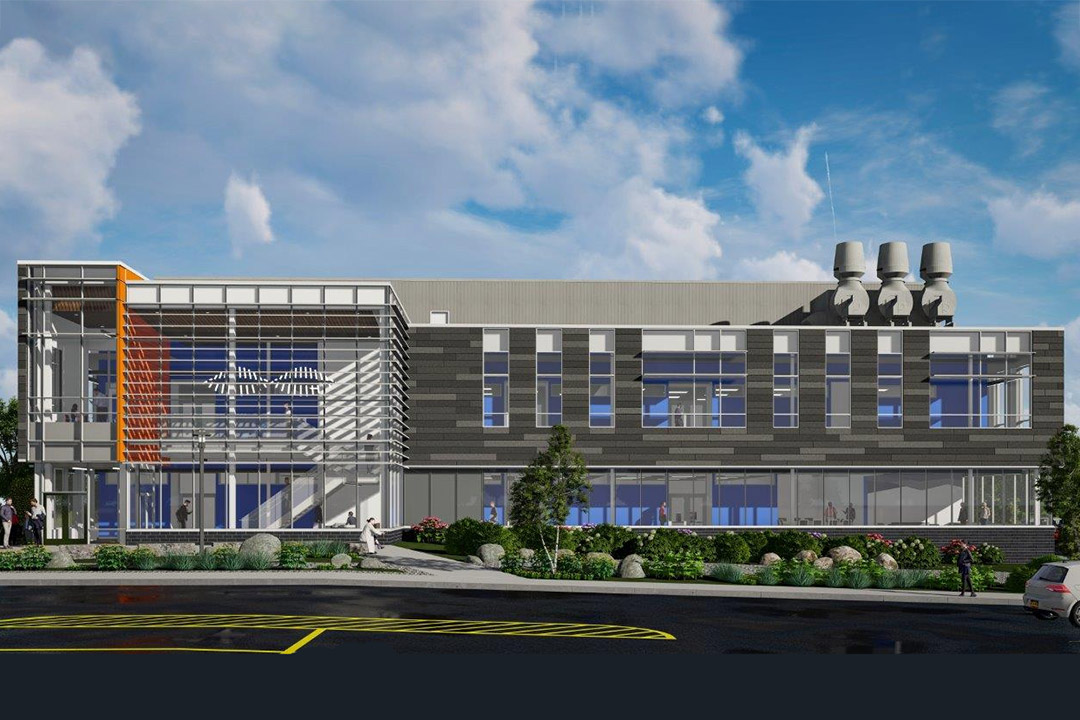RIT begins construction of two-story research facility near Global Village
New building will have capacity for multiple science, engineering, and computing laboratories
Facilities Management Services
A rendering of the new research building that is under construction on the southwest side of campus near Global Village.
RIT is expanding its research footprint to accommodate the university’s growing research portfolio.
Preliminary construction of a modern research facility has been underway since mid-summer. The RIT Research Building, on the southwest side of campus near R Lot, will provide more laboratory space in science, computing, and engineering.
The new building will be 39,200 square feet spread over two floors. Occupancy is expected in fall 2024.
Tori Budgeon-Baker, associate director of Planning and Design Services, who is overseeing the design portion of the project, and Mark Williams, principal project manager with Construction Services, both of RIT’s Facilities Management Services, began planning for the new building in 2022.
“This is an opportunity to further develop the southwest part of campus,” said Budgeon-Baker. “It’s an opportunity to really develop the entrance to the Global Village side of campus.”
Supply chain issues for the project have been a challenge. Anticipating some of the essential needs for the building, Williams was able to order several key pieces of equipment even before groundbreaking.
“We identified those items that had a real long lead time and preordered. Before we even hired the contractor for the electrical or mechanical or general architectural work, we purchased air handlers, electrical switch gear, and assigned installation to subcontractors as we were bidding,” he said.
Both managers see the project as fast paced compared to others done or underway. The research building is a bonded project and funding is not coming out of operating or capital budgets.
Another challenge for the team has been understanding who would be using the facility.
“This one has been interesting, in that respect. Something like the SHED, the theater, the stadium, we know the end user and we bring them in right away. In this case, we don’t know the end users,” said Budgeon-Baker.
Williams agreed. “We build for any kind of research—wet lab, dry, or whatever kind of infrastructure. We have to try to anticipate as best we can using our institutional knowledge to come up with a plan for a building that will be functional. Once the researchers come in, they will see the lab space, and we can build out for them.”
Several of the labs have already been allocated, specifically five to faculty in the College of Science, three to the Kate Gleason College of Engineering and one to the Golisano College of Computing and Information Sciences. The remaining labs will be assigned in the future by Ryne Raffaelle, RIT’s vice president for Research, as new faculty are hired.
There were a few minor surprises that have added to the overall construction process—from relocating faculty and staff in the temporary trailers that were in R Lot to working with the town of Henrietta on ensuring that the new building will not impede fire and police access lanes.
Both Williams and Budgeon-Baker acknowledged campus peers and regional contractors, many of whom have done work at RIT before this current project.
“Mark and I may be the RIT ‘face’ but it’s not just us. It is a whole team that makes these projects come together,” Budgeon-Baker said. “We are just the conductors.”
The architects for the project are HBT Architects, now part of MRB Group. Architects also worked on the SHED project teamed with William Rawn Associates. The Construction Management firm is DGA Builders.













